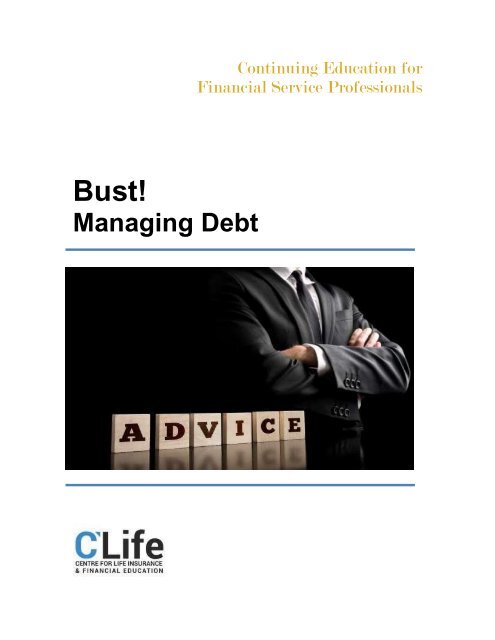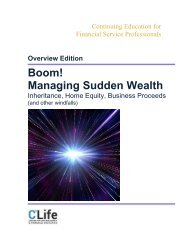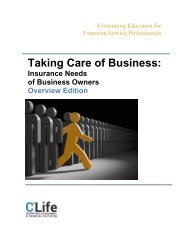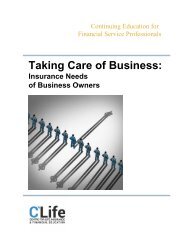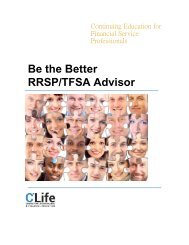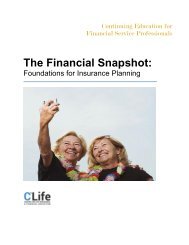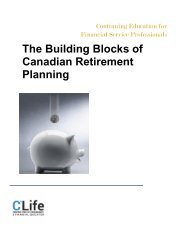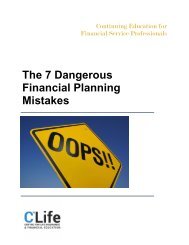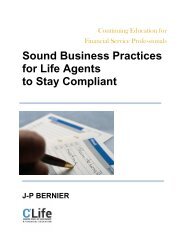Bust! Managing Debt
You have clients in debt. How can we be so sure? Statistics show that roughly 80% of Canadians are in debt and spend an average of 14% of after-tax income on their debt. All debt isn’t bad but, for many, debt is a four-letter word. This course fills in the blanks on debt: who goes into debt, how people go into debt, what they can do about it, and how they can crawl out from under its burden. It give you information you can use to advise your clients on controlling and eliminating debt, and includes useful details about debt management and consolidation.
You have clients in debt. How can we be so sure? Statistics show that roughly 80% of Canadians are in debt and spend an average of 14% of after-tax income on their debt. All debt isn’t bad but, for many, debt is a four-letter word.
This course fills in the blanks on debt: who goes into debt, how people go into debt, what they can do about it, and how they can crawl out from under its burden. It give you information you can use to advise your clients on controlling and eliminating debt, and includes useful details about debt management and consolidation.
Create successful ePaper yourself
Turn your PDF publications into a flip-book with our unique Google optimized e-Paper software.
<strong>Bust</strong>!<br />
<strong>Managing</strong> <strong>Debt</strong><br />
Continuing Education for<br />
Financial Service Professionals
Copyright 2016 CLIFE Inc.<br />
All rights reserved. Any reproduction of parts or all of this book and its contents by<br />
any means electronic or mechanical is prohibited.<br />
<br />
<strong>Bust</strong>! <strong>Managing</strong> <strong>Debt</strong> is relevant to all those who work in the financial services<br />
industry or in association with life insurers. The information in the course is<br />
provided for educational purposes only; it should not be construed or interpreted<br />
as providing advice. Agents and advisors should always seek guidance from their<br />
principals and compliance experts in regards to informing themselves and others<br />
about details of the products they sell and other considerations of their business.<br />
<br />
<br />
We welcome all feedback and suggestions for additions to the course. Please send<br />
your comments to info@clifece.ca.<br />
CLIFE INC.<br />
6 – 14845 Yonge Street<br />
Suite 139<br />
Aurora, ON<br />
L4G 6H8<br />
www.clifece.ca<br />
<strong>Bust</strong>! <strong>Managing</strong> <strong>Debt</strong> provides continuing education credits upon satisfactory completion of an<br />
online test. Please see the website for details or email info@clifece.ca.<br />
2
Table of Contents<br />
1. The <strong>Debt</strong> Problem 4<br />
2. Good <strong>Debt</strong>, Bad <strong>Debt</strong> 7<br />
3. Some Causes of <strong>Debt</strong> 9<br />
4. Understanding the Credit Report and<br />
Credit Scores 22<br />
5. The Money Under the Mattress 28<br />
6. Digging Out: <strong>Debt</strong> Consolidation,<br />
Management and the Consumer Proposal 40<br />
7. The Last Resort 45<br />
8. How to Reduce <strong>Debt</strong> 49<br />
3
1. The <strong>Debt</strong> Problem<br />
<br />
This course addresses one aspect of personal<br />
finance about which most of us would rather turn<br />
a blind eye: debt.<br />
<br />
In 2015, Canadian household debt to income ratio<br />
hit a record high of over 165%. That means<br />
households held more than $1.65 in debt for<br />
every dollar of disposable income.<br />
<br />
The Bank of Montreal reports that roughly 80% of Canadians are in debt and<br />
nearly two-thirds would have trouble affording their debt if interest rates rise<br />
by 2%. 1<br />
<br />
Consumers have been drawing down their savings to buy houses, cars,<br />
furniture and clothing. Credit-card spending rose by 8% in 2015, with spending<br />
on restaurants and fast food up more than 12%.<br />
<br />
Canadians now spend an average 14% of after-tax income on their debts.<br />
<br />
Some will manage these debts, and some will not. Those who don’t are going<br />
to find themselves in financial difficulty and some will go broke.<br />
<br />
Being broke is quite different from being poor. Poverty results from little or no<br />
money being present for the individual or the household. It is a condition that<br />
tends to be permanent, or almost so. Being broke is event-based. It occurs as a<br />
result of ill fortune or improvidence. A person had money, something<br />
1 http://www.theglobeandmail.com/globe-investor/personal-finance/household-finances/canadianhouseholds-still-adding-debt-but-pace-slowing-equifax/article26366796/<br />
4
happened once or a number of times, and the money they have is now gone ---<br />
or it just isn’t enough to pay the bills. He or she is broke.<br />
<br />
Being broke gives rise to a witches’ brew of emotions:<br />
o Blame, such as the type of blame that arises from financial<br />
mismanagement or squandering savings.<br />
o Guilt;<br />
o Sorrow;<br />
o Greed;<br />
o Anger.<br />
<br />
Failure to take personal responsibility for finances due to lack of interest or<br />
lack of knowledge can also be a root cause of financial disaster. However,<br />
pointing the finger at a spouse or partner doesn’t turn the tables.<br />
<br />
However, being broke --- too little money to pay the bills --- can result from<br />
circumstances that can’t be anticipated. Even when planning and saving may<br />
have been done in better times, due to circumstance, it is no longer enough to<br />
shoulder the financial burden.<br />
<br />
The issue of insolvency is also especially pertinent in regards to seniors. A<br />
review of 6,000 insolvency files in 2013 and 2014 by a bankruptcy trustee in<br />
Ontario found the highest-risk groups for insolvency are seniors followed by<br />
single parents, and people with large student loans who do not qualify for<br />
traditional low-cost borrowing options, such as lines of credit. 2<br />
<br />
As the saying goes, tough times call for tough measures.<br />
o Let’s see how people go broke so that you can advise clients on<br />
behaviour that might be leading in this direction. An ounce of<br />
prevention is worth a pound of cure!<br />
2 http://www.theglobeandmail.com/report-on-business/payday-loans-predatory-loan-sharks-or-crucial-fix-ina-pinch/article24463029/<br />
5
o<br />
o<br />
o<br />
o<br />
We’ll review the importance of the credit score.<br />
We will also look at ways of finding “money in the mattress,” to find<br />
money that can be used for debt payment.<br />
We’ll look at what happens when being broke becomes insolvency and<br />
the only avenues open are a consumer proposal or bankruptcy.<br />
Finally, we’ll look at some smart and easy ideas to reduce debt.<br />
<br />
This information gives perspective on one side of financial management that is<br />
often overlooked. It helps the advisor prepare answers if he or she detects<br />
trouble ahead or receives the distressful phone call from the client who is in<br />
debt trouble and needs solutions.<br />
CLICK HERE TO ORDER<br />
6
7


